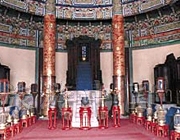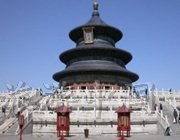Temple of Heaven
The Temple of Heaven in the southern part of Beijing is Chinas largest existing complex of ancient  sacrificial buildings with a history of over 500 years. Occupying an area of 273 hectares, it is three times the area of the Forbidden City.
sacrificial buildings with a history of over 500 years. Occupying an area of 273 hectares, it is three times the area of the Forbidden City.
In ancient China, emperors considered themselves as The Son of Heaven, inheriting supreme power to dominate the world. Originally built in the Ming Dynasty (1368- 1644) in 1420, the Temple of Heaven was the sacrificial place for emperors to hold prayer and sacrificial ceremonies.
With an area of about 2,700,000 square meters (one square mile), the Temple of Heaven is much bigger than Forbidden City and a little smaller than Summer Palace. It is enclosed by a long wall. The northern part is semicircular symbolizing Heaven and the southern part is square symbolizing Earth. This design reflects ancient Chinese thought of The heaven is round and the earth is square. Main constructions include Hall of Prayer for Good Harvest (Qi Nian Dian), Circular Mound Altar (Yuan Qiu Tan), Imperial Vault of Heaven (Huang Qiong Yu) and other associated buildings. A long bridge called Vermilion Steps Bridge (Dan Bi Qiao) runs along the north-south axis connecting most of the main buildings.
square symbolizing Earth. This design reflects ancient Chinese thought of The heaven is round and the earth is square. Main constructions include Hall of Prayer for Good Harvest (Qi Nian Dian), Circular Mound Altar (Yuan Qiu Tan), Imperial Vault of Heaven (Huang Qiong Yu) and other associated buildings. A long bridge called Vermilion Steps Bridge (Dan Bi Qiao) runs along the north-south axis connecting most of the main buildings.
It was entered into the world cultural heritage list in 1998.